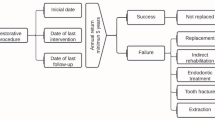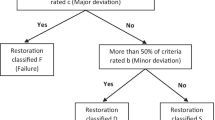Abstract
The failure of composite resin restorations in the posterior region is an ongoing concern in current clinical practice This study assesses possible factors and causes of the failure of restoration 1 year after their placement by fourth year dental students (on a 5-year degree course). While the systematic assessment of dental students does not appear to have received much attention in the field, this study asserts the need and benefit of an assessment methodology that can (1) predict the success or failure of restorations placed by dental students and (2) assist the clinical instructor in identifying the performance profile of each student. Eighty-one patients aged 26–77 years were treated by 81 undergraduates in a prospective cohort study from November 2013 to December 2015. One year after treatment, restorations were assessed by the same staff member who acted as the supervisor during the restoration placement. A CBR system was applied to make predictions about restorations. The CBR includes different machine learning techniques and statistical tests in the CBR cycle. The system calculates the relevant variables, which are used to predict failures. The accuracy of the system is measured with the AUC and the accuracy. The AUC obtained is 0.935 while the Kappa index and the accuracy are 91.36 and 0.75, respectively. In conclusion, factors related to the patient and to the treatment are associated to the failure of the restorative treatment. Of particular interest, the CBR was useful for the performance of a predictive model to estimate the probability of failure of resin restorations placed by students.

Similar content being viewed by others
References
Abutair H, Belghith A, AlAhmadi S (2019) CBR-PDS: a case-based reasoning phishing detection system. J Ambient Intell Hum Comput 10(7):2593–2606
American Dental Education Association (2018) Competencies for the new general dentist (as approved by the 2008 ADEA House of Delegates). J Dent Educ 72(7):823–826
Bassir SH et al (2014) Problem-based learning in dental education: a systematic review of the literature. J Dent Educ 78(1):98–109
Bouckaert RR (1995) Bayesian belief networks: from construction to inference. Doctoral dissertation, Utrecht, Netherlands
Brown MB, Forsythe AB (1974) Robust tests for equality of variances. J Am Stat Assoc 69:364–367
Chauhan R, Kaur H, Chang V (2011) Advancement and applicability of classifiers for variant exponential model to optimize the accuracy for deep learning, advancement and applicability of classifiers for variant exponential model to optimize the accuracy for deep learning. J Ambient Intell Hum Comput 24:1–10
Corchado JM, Mata A, De Paz JF, Del Pozo D (2008) A new CBR approach to the oil spill problem. ECAI 2008:643–647
Corchado JM, De Paz JF, Rodríguez S, Bajo J (2009) Model of experts for decision support in the diagnosis of leukemia patients. Artif Intell Med 46(3):179–200
D’Arcangelo C, Zarow M, De Angelis F, Vadini M, Paolantonio M, Giannoni M, D’Amario M (2014) Five-year retrospective clinical study of indirect composite restorations luted with a light-cured composite in posterior teeth. Clin Oral Invest 18(2):615–624
Da Rosa Rodolpho PA, Donassollo TA, Cenci MS, Loguercio AD, Moraes RR, Bronkhorst EM et al (2011) 22-Year clinical evaluation of the performance of two posterior composites with different filler characteristics. Dent Materg 27:955–963
De Paz JF, Rodríguez S, Bajo J, Corchado JM (2009) Case-based reasoning as a decision support system for cancer diagnosis: a case study. Int J Hybrid Intell Syst 6(2):97–110
De Paz JF, Bajo J, González A, Rodríguez S, Corchado JM (2012) Combining case-based reasoning systems and support vector regression to evaluate the atmosphere-ocean interaction. Knowl Inf Syst 30(1):155–177
De Paz JF, Tapia DI, Alonso RS, Pinzón CI, Bajo J, Corchado JM (2013) Mitigation of the ground reflection effect in real-time locating systems based on wireless sensor networks by using artificial neural networks. Knowl Inf Syst 34(1):193–217
Dietterich TG (1998) Approximate statistical tests for comparing supervised classification learning algorithms. Neural Comput 10:1895–1923
Eve Elizabeth J et al (2014) Performance of dental students versus prosthodontics residents on a 3D immersive haptic simulator. J Dent Educ 78(4):630–637
Ferracane J (2013) Resin-based composite performance: are there some things we can’t predict? J Dent Mater 29:51–58
Ficet-Cauchar V, Porquet C, Revenu M (1999) CBR for the management and reuse of image-processing expertise: a conversational system. Eng Appl Artif Intell 12(6):733–747
Gimenez T, Piovesan C, Braga MM, Raggio DP, Deery C, Ricketts DN, Ekstrand KR, Mendes FM (2015) Clinical relevance of studies on the accuracy of visual inspection for detecting caries lesions: a systematic review. Caries Res 49(2):91–98
Hamburger JT, Opdam NJ, Bronkhorst EM, Kreulen CM, Roeters JJ, Huysmans MC (2011) Clinical performance of direct composite restorations for treatment of severe tooth wear. J Adhes Dent 13:585–593
Ismail AI, Sohn W, Tellez M, Amaya A, Sen A, Hasson H, Pitts NB (2007) The International Caries Detection and Assessment System (ICDAS): an integrated system for measuring dental caries. Commun Dent Oral Epidemiol 35(3):170–178
Johnstone-Dodge V, Bowen DM, Calley KH, Peterson TS (2014) A faculty development course to enhance dental hygiene distance education: a pilot study. J Dent Educ 78(9):1319–1330
Khanum A, Mufti M, Javed MY, Shafiq MZ (2009) Fuzzy case-based reasoning for facial expression recognition. Fuzzy Sets Syst 160(2):231–250
Kolodner J (1993) Case-based reasoning. Morgan Kaufmann, Burlington
Landwehr N, Hall M, Frank E (2004) Logistic model trees. Kluwer Academic, New York, pp 1–54
Lausch J et al (2015) Resin infiltration of fissure caries with various techniques of pretreatment in vitro. Caries Res 49(1):50–55
Levene H (1960) Robust tests for equality of variances. In: Olkin I (ed) Contributions to probability and statistics. Stanford Univ. Press, Palo Alto
Makhija SK, Gordan VV, Gilbert GH, Litaker MS, Rindal DB, Pihlstrom DJ et al (2011) Practitioner, patient and carious lesion characteristics associated with type of restorative material: findings from The Dental Practice-Based Research Network. J Am Dent Assoc 142(6):622–632
Makhija SK, Gilbert GH, Funkhouser E, Bader JD, Gordan VV, Rindal DB, Pihlstrom DJ, Qvist V (2014) Characteristics, detection methods and treatment of questionable occlusal carious lesions: findings from the national dental practice-based research network. Caries Res 48(3):200–207
Manhart J, Chen HY, Mehl A, Hickel R (2010) Clinical study of indirect composite resin inlays in posterior stress-bearing preparations placed by dental students: results after 6 months and 1, 2, and 3 years. Quintessence Int 1:399
Navarro M, De Paz JF, Julián V, Rodríguez S, Bajo J, Corchado JM (2012) Temporal bounded reasoning in a dynamic case based planning agent for industrial environments. Expert Syst Appl 39(9):7887–7894
Pallesen U (2013) Longevity of posterior resin composite restorations in permanent teeth in Public Dental Health Service. A prospective 8 years follow up. J Dent. 2013(4):297–306
Pinzón C, De Paz JF, Navarro M, Bajo J, Julián V, Corchado JM (2011) Real-time CBR-agent with a mixture of experts in the reuse stage to classify and detect DoS attacks. Appl Soft Comput 11(7):4384–4398
Pinzón CI, De Paz JF, Herrero Á, Corchado E, Bajo J, Corchado JM (2013) idMAS-SQL: intrusion detection based on MAS to detect and block SQL injection through data mining. Inf Sci 231:15–31
Prabukumar M, Agilandeeswari L, Ganesan K (2019) An intelligent lung cancer diagnosis system using cuckoo search optimization and support vector machine classifier. J Ambient Intell Hum Comput 10(1):267–2939
Quinlan JR (1993) C4.5: Programs for machine learning. Morgan Kaufmann, Burlinton
Requena F, Martín N (2006) Ciudad a major improvement to the network algorithm for Fisher’s exact test in 2 × c contingency tables. Comput Stat Data Anal 51(2):490–498
Royston P (1982) Algorithm AS 181: the W test for normality. Appl Stat 31:176–180
Shuler CF (2014) Dental school: balancing education and training. J Dent Educ 78(5):655–656
Singh UP, Tikku AP, Chandra A, Loomba K, Boruah LC (2011) Influence of caries detection dye on bond strength of sound and carious affected dentin: an in vitro study 1(14):32–35
Tiwana KK et al (2014) Gender issues in clinical dental education. J Dent Educ 78(3):401–410
Unlu N, Ermis RB, Sener S, Kucukyilmaz E, Cetin AR (2010) An in vitro comparison of different diagnostic methods in detection of residual dentinal caries. Hindawi Publishing Corporation International Journal of Dentistry, London
Vapnik V (1995) The nature of statistical learning theory. Springer, Berlin
Wijnand HP, van de Velde R (2000) Mann–Whitney/Wilcoxon’s nonparametric cumulative probability distribution. Comput Methods Programs Biomed 63(1):21–28
Author information
Authors and Affiliations
Corresponding author
Additional information
Publisher's Note
Springer Nature remains neutral with regard to jurisdictional claims in published maps and institutional affiliations.
Rights and permissions
About this article
Cite this article
Aliaga, I.J., De Paz, J.F., Vera, V. et al. Prediction and failure analysis of composite resin restorations in the posterior sector applied in teaching dental students. J Ambient Intell Human Comput 11, 4537–4544 (2020). https://doi.org/10.1007/s12652-020-01804-7
Received:
Accepted:
Published:
Issue Date:
DOI: https://doi.org/10.1007/s12652-020-01804-7




